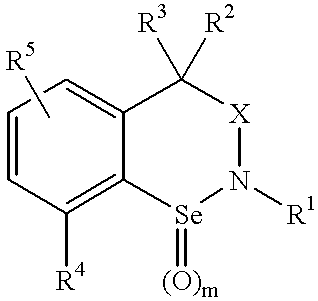Uses of novel organoselenium compounds with pro-oxidant activity
a technology of organoselenium compounds and pro-oxidant activity, which is applied in the field of novel organoselenium compounds with pro-oxidant activity, can solve the problems of selenol and/or diselenide toxicity of organoselenium compounds of the selenol and/or diselenide type, and the irreversible cell death
- Summary
- Abstract
- Description
- Claims
- Application Information
AI Technical Summary
Benefits of technology
Problems solved by technology
Method used
Image
Examples
example 1
3,3-Dimethyl-7-nitrobenzisoselenazoline
Step 1. Preparation of 2-bromo-3-nitrobromomethylbenzene
To a mixture of 2-bromo-3-nitrotoluene (6.48 g, 30 mmol) and N-bromosuccinimide (5.34 g, 30 mmol) in 100 ml of CCl.sub.4 is added 2,2'-azobis(2-methylpropionitrile) (AIBN, 300 mg, 1.8 mmol). The mixture thus obtained is heated under reflux for 32 hours and then cooled to room temperature. The solid is filtered and rinsed with CCl.sub.4. The filtrate is evaporated to dryness to give a slightly yellow oil (10.1 g). Analysis of the .sup.1 H NMR spectrum of this crude product indicates that it is a mixture of the expected compound, the dibrominated product and the starting product in a proportion of 57:10:33. The crude product is used directly in the following step.
Step 2. Preparation of 2-bromo-3-nitrophenylacetonitrile
The crude brominated product obtained above (10.1 g) is taken up with 75 ml of methanol. Sodium cyanide (1.47 g, 30 mmol) is added in one portion. The mixture is stirred at roo...
example 2
N-Acetyl-4,4-dimethyl-8-nitrobenzisoselenazine
Step 1. Preparation of 2-(2-bromo-3-nitrophenyl)-2-methylpropylammonium trifluoroacetate
The 2-(2-bromo-3-nitrophenyl)-2-methylpropionitrile prepared according to step 3 of Example 1 (1.0 g, 3.7 mmol) is dissolved in 10 ml of anhydrous THF. BH.sub.3.THF (10 ml, 1.0 M solution in THF, 10 mmol) is added. The reaction mixture is maintained under reflux for 3 hours before being cooled to room temperature. 12 ml of an aqueous solution of trifluoroacetic acid (50%) is added dropwise. The mixture is heated under relux for 1 hour. The solvents and the trifluoroacetic acid are evaporated. The residue is redissolved in 20 ml of THF and evaporated to dryness. A crude solid product is obtained which contains essentially the desired product and is used directly in the following acetylation step.
Step 2. Preparation of N-acetyl-2-(2-bromo-3-nitrophenyl)-2-methylpropylamine
To a solution of the above crude ammonium salt dissolved in 10 ml of anhydrous THF...
example 3
4,4-Dimethyl-8-nitrobenzisoselenazine
A solution of N-acetyl-4,4-dimethyl-8-nitrobenzisoselenazine (70 mg, 0.22 mmol) of Example 2 dissolved in 1 ml of acetic acid and 1 ml of concentrated hydrochloric acid is heated under reflux for 20 hours. The reaction mixture cooled to 0.degree. C. is neutralized with an aqueous solution of NaOH (10%), then extracted with ethyl acetate. The combined organic phases are washed with a saturated aqueous solution of NaCl, dried over MgSO.sub.4 and evaporated. The residue is purified by silica gel column chromatography (eluent: EtOAc:cyclohexane, 1:3) to provide the the desired product (32 mg, 53%) as a yellow solid.
M. Pt.: 108.degree. C.
MS (EI): 272 (52), 226 (100), 196 (48), 115 (57).
.sup.1 H NMR: 1.33 (s, 6H), 3.15 (br s, 1H), 3.29 (s, 2H), 7.27 (t, 1H, J=8.3 Hz), 7.75 (dd, 1H, J=1.3, 8.3 Hz), 8.22 (dd, 1H, J=1.3, 8.3 Hz).
PUM
| Property | Measurement | Unit |
|---|---|---|
| temperature | aaaaa | aaaaa |
| temperature | aaaaa | aaaaa |
| pH | aaaaa | aaaaa |
Abstract
Description
Claims
Application Information
 Login to View More
Login to View More - R&D
- Intellectual Property
- Life Sciences
- Materials
- Tech Scout
- Unparalleled Data Quality
- Higher Quality Content
- 60% Fewer Hallucinations
Browse by: Latest US Patents, China's latest patents, Technical Efficacy Thesaurus, Application Domain, Technology Topic, Popular Technical Reports.
© 2025 PatSnap. All rights reserved.Legal|Privacy policy|Modern Slavery Act Transparency Statement|Sitemap|About US| Contact US: help@patsnap.com



